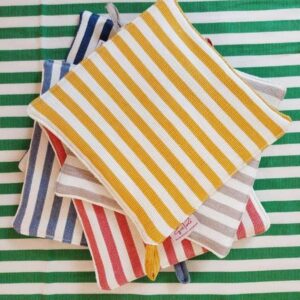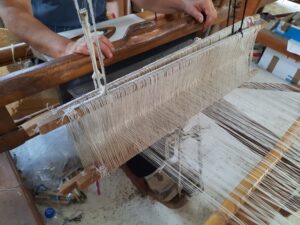The loom is a wooden device used to weave carpets, tapestries, and fabrics, but also folk costumes in multicolored patterns and motifs. The basic purpose of each loom is to hold the warp threads under tension to facilitate the interweaving of the weft threads. The precise shape of the loom and its mechanics may vary from north to south of the country, but the basic function is the same.
Although it is not possible to know exactly when the loom weaving craftsmanship made its start, this craft in Albania is no doubt a tradition preserved and handed down through generations. Loom weaving has been traditionally used by girls and women, once to meet their family needs, today for market needs related to cultural tourism activity. In recent years, in addition to garments with folk motifs, loom works are also showcasing the traditional and the modern being interwoven. This tradition, while for earlier generations emerged out of survival, later continued as a handicraft, to date has turned into real art. In addition to demands made domestically, loom works have also sparked the interest of foreigners.
Fabric is a very important component of Shkodra household, starting from the bezja e sofrës (table baize cover, tablecloth) to curtains, bed sheets, covers, overlays and everything else needed at home. Shkodra people preserve their traditions with fanaticism. Even today this craft is rather widespread and practices the same style inherited by our ancestors. Fabric weaving on a loom starts with choosing the yarn, based on thickness and color. Next, the work proceeds with winding, which is very important to produce a high-quality fabric.
The thread is placed on a wooden shaft, which passes through the “heddles frame” and the “reed”, is connected to another shaft in front of the loom and so the fabric weaving is about to start. The tools used in weaving are beams and the “shuttle”. The surface area considered necessary for weaving fabrics with silk threads, should be 200 m2. Today, the Mjeda family, taking advantage of the experience gained over the years, has made some modifications reducing the necessary working area to about 30 m2.





